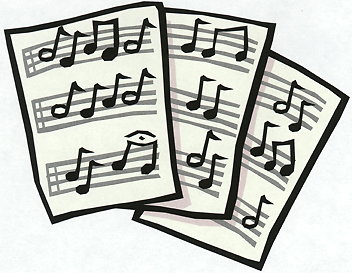CATALYTIC REACTIONS?
If you have a photo or other
graphic that reflects an aspect of life
(including laboratory life) or a
quotation that scientists might
appreciate that would be fit to print
in the space to the right, why not
send it to us via e-mail:
<catalyst@nih.gov>; fax: 402-4303; or mail: Building 2, Room 2E26.
Also, we
welcome "letters to the editor" for publication and your reactions
to anything on the Catalyst pages.
In Future Issues...
IRP Research Roundup
Research Festival/Job Search
Teams for the Road
 |
Kids' Catalyst: Tone Trek
Clanging Glasses
You’ll need:
![]() One set of three glasses
(real glass–plastic doesn’t work so well–wonder why?)
One set of three glasses
(real glass–plastic doesn’t work so well–wonder why?) ![]() Another set of three glasses of similar shape, but different size
Another set of three glasses of similar shape, but different size ![]() Water
Water ![]() A pencil
A pencil
Fill the first glass to the top with water. Pour the water from the first glass into the second glass until they’re even. Then take the second glass and pour water into the third glass to make them even. Take one of the 1/4-full glasses and fill it all the way up. Now you have three glasses—one is full, one 1/2 full, one 1/4 full.
Now take a pencil and tap the side of the glasses. You don’t need a piano to tell that they all sound different. (If you have a music teacher around, ask them to write the notes down on the staff.)
Now it gets really interesting. Use the same method to fill the next set of glasses. They’re not the same glasses, but they still follow the same pattern. You’ll find that the difference between the first and second glasses is the same as the second and third. Do you think this will work for glasses that have a completely different shape? Give it a try. Do you think the difference will be the same or less with four glasses filled in 1/4-glass increments? What about 12?
Singing Coins (in Balloon)
You’ll need:
![]() A balloon
A balloon ![]() A penny, a nickel, a dime, and a quarter
A penny, a nickel, a dime, and a quarter
This one is really fun! Blow up your balloon, choose a coin and place it inside the balloon, and twirl. Pretty strange sound, huh? Try whirling at different speeds, and write down how the sound changes when it’s going fast or slow. Try this with the other coins, too. Does a quarter sound different from the dime? What about how inflated the balloon is? Does that change the tone?
Whistling Paper
You’ll need:
![]() Looseleaf paper (to begin)
Looseleaf paper (to begin)
![]() Scissors
Scissors ![]() A pencil
A pencil
Make a whistle out of a piece of paper. How? Get some looseleaf paper and cut a strip about six inches long and two inches wide. Fold it in half (widthwise), and in the middle of the fold poke a pencil all the way through the paper. Fold it in half again, touch the two outside flaps (but don’t smash them together), and blow through the folds. Be careful, this can be much louder than you would ever think a piece of paper could get! Try this with different size holes, different types of paper (file folders, tissue paper, index cards), and with different people.
|
PUBLISHER EDITORS Lance
Liotta
|
SCIENTIFIC
EDITOR MANAGING
EDITOR COPY
EDITOR CONTRIBUTING
WRITERS |
EDITORIAL ADVISORY BOARD Jorge
Carrasquillo, CC
|